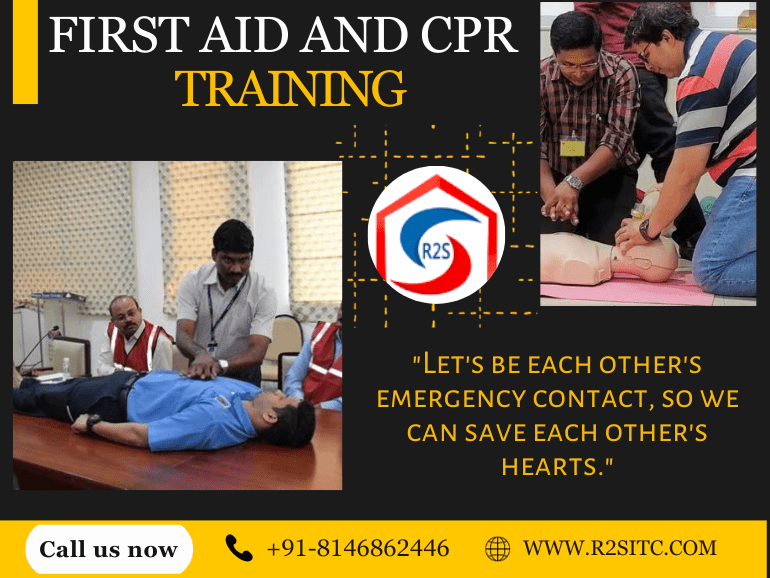Introduction
First Aid and CPR training are two crucial skills that can make a significant difference in emergency situations. Whether it’s a minor injury or a life-threatening incident, being prepared to respond effectively can save lives. In this comprehensive guide, we will explore the importance of First Aid and CPR training, the key concepts and techniques involved, and how you can become certified in these life-saving skills.
Why First Aid and CPR Training Matters
1.Immediate Response Saves Lives: In emergencies, time is of the essence. Knowing how to provide immediate care can prevent a situation from intensify and increase the chances of a positive outcome.
2.Strengthen Safety Awareness: First Aid and CPR training increase your awareness of potential hazards and risks in your environment. This knowledge helps in accident prevention.
3.Empowerment: Learning these skills empowers you to take control of a situation and potentially save a life. It instills confidence in your ability to respond effectively.
4.Community and Workplace Safety: Many workplaces and communities require individuals to be trained in First Aid and CPR to ensure the safety of employees and residents.
First Aid Training
First Aid training covers a wide range of skills and knowledge, including:
1.Assessment: Learn how to assess the situation and the condition of the victim. This includes checking for responsiveness, breathing, and severe bleeding.
2.Wound Care: Understand how to clean and dress wounds properly to prevent infection and promote healing.
3.Burn Treatment: Understand how to treat burns and scalds, including recognizing the severity of burns and providing appropriate care.
4.Poisoning: Recognize the signs of poisoning and know how to respond, including contacting emergency services.
5.Basic Life Support: Gain knowledge of basic life support techniques, such as chest compressions and rescue breathing.
CPR Training
CPR is a critical skill used to maintain blood flow and oxygen delivery to vital organs when someone’s heart has stopped beating. Key elements of CPR training include:
1.Chest Compressions: Learn the proper technique for performing chest compressions, which help circulate blood throughout the body.
2.Rescue Breathing: Understand how to provide rescue breaths to supply oxygen to the victim’s lungs.
3.AED (Automated External Defibrillator) Use: Gain familiarity with AEDs, which can deliver electric shocks to restore a normal heart rhythm.
4.Child and Infant CPR: Specialized techniques for performing CPR on children and infants.
5.Team Dynamics: Learn how to work effectively with others in a CPR team, such as in a healthcare setting.
Certification and Training Programs
To become proficient in First Aid and CPR, it’s advisable to enroll in a recognized training program. These programs often offer certification upon successful completion. Some common organizations that provide certification include the American Heart Association (AHA), American Red Cross, and various local healthcare providers and training centers.
The certification process typically involves a combination of classroom instruction and hands-on practice. Depending on the program, you may need to pass written exams and demonstrate your skills through practical assessments.
Certification is usually valid for a specified period, often two years, after which you’ll need to renew it by taking a refresher course and passing any required evaluations.
Real-Life Applications
One of the best ways to appreciate the importance of First Aid and CPR training is to explore real-life scenarios where these skills have made a difference:
1. Car Accidents: Bystanders with First Aid training can provide immediate assistance to accident victims, stabilizing them until professional help arrives.
2. Heart Attacks: Quick CPR intervention can double or even triple the chances of survival for someone experiencing a heart attack.
3. Drowning Incidents: Knowledge of CPR is essential for lifeguards and anyone near water to respond effectively to drowning emergencies.
4. Workplace Injuries: Injuries in the workplace can range from minor cuts to severe accidents. First Aid training ensures that employees can provide immediate care while waiting for medical professionals.
5. Natural Disasters: In the aftermath of disasters like earthquakes or hurricanes, First Aid skills are invaluable in providing immediate assistance to injured individuals.
R2SITC(Road 2 Safety International Training and Consultancy) | Best Safety Training Institute
R2S International Training & Consultancy is about “ROAD TO SAFETY” for Health, Safety, and Environment in conjunction with Quality Management. R2SITC ensures safety in every industry in every occupation for creating the best health and environment in the future.
Our expert team with international & national qualifications in their respective area experienced professionals, and very well known in the respective field due to their unique skills & expertise. Our advisers, trainer, auditors & consultants have worked and completed many projects in UAE, UK, USA, INDIA, Qatar, Saudi Arabia, Kuwait, Oman, Bahrain, and recognized by respective clients & authorities.
We have expertise in almost every industry (e.g., Energy Sector, Oil & Gas, Construction, Engineering, Manufacturing, Fertilizer, Cement, Paper, Telecom, General Industry, and more). We are offering forklift training in Punjab and the best fire and safety courses in Hoshiarpur.
Our Courses
1. Scaffold Training
2. Work At Height Training
3. Rigger Training
4. Nebosh Training Centre
5. Fire and Safety Diploma
6. Forklift Training
7. Safety Officer Course
8. IOSH Training Centre
9. First Aid And CPR Training
10. Basic Fire Fighting Training India
Conclusion
First Aid and CPR training are not just skills; they are tools for empowerment and lifesaving. In times of crisis, knowing what to do can mean the difference between life and death. By taking the initiative to learn these skills and seeking certification, you not only enhance your own safety but also contribute to the well-being of your community.
Remember, it’s never too late to start learning. Enroll in a reputable training program, practice regularly, and stay current with updates and certifications. You never know when you might be called upon to be a hero and save a life with your First Aid and CPR skills.


